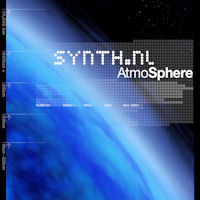The next task was to construct the power supply. In the picture you can see all the parts that PAIA supplies in the kit. On the top right you can see the alternative front panel that is provided with holes for the leds and power switch. On the left is the PCB. This PCB is used for all the power supply variations that PAIA supplies. So you have to see in the manual which components to install and which you don't. There is also a jumper on the PCB that you need to mount. I almost forgot it. So pay attention :)
Here you see the front panel installed in the 19 inch cabinet. There is a power led that shows if the external power is there and also two leds for the +15V and -15V outputs from the power supply. I think PAIA came up with a very neat solution for it in this way. It doesn't take up any extra space in the cabinet and you can still mount 10 Frac units in the case. It is a bit fiddling around though to get the leds on the right length on the PCB so that they just stick out of the holes of the front panel.
And here you can see the finished PCB on the inside of the cabinet. Also a bit of fiddling to get it in. The holes are already in the side of the cabinet to mount it by the way. Just make sure you have the side panels with the holes to the front. I still need to hook up the power from the external adapter, but wanted to make sure it fits. The only thing that is a bit odd is that when you need to hook up an module, you need to take the PSU out again to solder the wires for the power of the module on the PCB. On the other side (on the module itself) PAIA uses a connector. I think they should have done the same on the power supply itself. That would have made it a bit more flexible. Ah well. It will work in the end I guess.
skip to main |
skip to sidebar

 Posts
Posts

 Posts
Posts


BorkHavn - 2020

PrimiTiveS - 2013

Apollo - 2011

Refuge en Verre - 2010

OceanoGraphy - 2009

AtmoSphere - 2008

AeroDynamics - 2007
All albums released by:
Groove Unlimited
A blog about my music, my studio and my DIY projects.
Subscribe To


About me
- Synth.nl
- Netherlands
- My Name is Michel van Osenbruggen and I produce synthesizer music under the name Synth.nl. You can find my main website at http://www.synth.nl/
Support Me!
Please buy my music if you like what you read or hear on this blog. You will find the sales links for my music when you click an album below. You will support me and my record label so that I can release more music in the future.
My Releases

BorkHavn - 2020

PrimiTiveS - 2013

Apollo - 2011

Refuge en Verre - 2010

OceanoGraphy - 2009

AtmoSphere - 2008

AeroDynamics - 2007
All albums released by:
Groove Unlimited
Followers
Twitter Updates
Labels
- studio
- synthnl
- music
- releases
- synthesizers
- albums
- apollo
- diy
- analog
- modulars
- radio
- trips
- digital
- atmosphere
- 3D
- oceanography
- videos
- ronboots
- equipment
- electronics
- yusynth
- roland
- website
- interviews
- refuge
- construction
- remy
- aerodynamics
- groove
- reviews
- synthesizer
- furniture
- PAIA
- tech
- c64
- collaborations
- music releases
- schallplatte
- sid
- velleman
- yamaha
- 9700S
- c4d
- cinema4d
- primitives
- synthesizer music
- korg
- repairs
- acoustics
- animations
- asm-2
- dutchmasters
- software
- awards
- leak
- renderfarm
- klee
- motm
- oakley
- samplers
- moog
- deckards dream
- mb-6582
- mfos
- osenbruggen
- 3dprinter
- cs80
- printer
- AVRSynth
- borkhavn
- braska
- cabling
- sammichfm
- decoration
- dotcom
- electronic music
- formant
- nattefrost
- retro
- ron boots
- sammichsid
- samples
- schallwende
- virtiso
- waldorf
- ARP
- artwork
- beisbroek
- colaborations
- computers
- jarre
- palaeontology
- planetarium
- reverb
- robots
- robpapen
- schallwelle
- airco
- airplay
- christmas
- classical
- commodore
- design
- groove unlimited
- kurzweil
- renders
- sonar
- wall-e
- apple
- bit
- cakewalk
- cinema
- clavia
- contributions
- elka
- em
- jeffrey
- k8200
- mods
- mp3
- reversed
- rme
- sequential circuits
- sony
- soundbanks
- ultimaker
- video
- 3ds
- access
- alesis
- arturia
- bellerob
- bridechamber
- cinema 4d
- collection
- cwejman
- demos
- dexter
- dinosaurs
- edge
- ems
- esp12
- eventide
- flac
- games
- hip bass
- html5
- jurassic
- jurassic park
- madi
- monitoring
- novation
- pictures
- release
- sound effects
- tractor
- wogglebug
- work
- wwf
- 3dstudio.
- Arduino
- Siel
- adobe
- album
- amazon
- amiga
- analogy
- anatek
- apogee
- artiled
- astronomy
- autodesk
- bandcamp
- berliner schule
- blender
- books
- buchla
- business
- cinema4d.
- clocking
- cloudpage
- collaborarions
- company
- contest
- discount
- display
- documentary
- downloads
- e-day
- e-live
- elctronics
- electronic music.
- elive
- emportal
- emu
- festival
- gadgets
- gear
- gemini
- glennmain
- hal9000
- holiday
- ipad
- itunes
- joomla
- jupiter
- led
- led lighting
- lexicon
- lightwave
- m-audio
- magic smoke
- makerbot
- manuals
- maxon
- models
- modules
- moon modular
- mutec
- nasa
- newtek
- nord lead 4
- oberheim
- oculus
- oled
- origin
- overviews
- pcb
- pet
- pixar
- ppg
- private cloud
- projects
- putney
- quirobinez
- r2d2
- robot
- sampler
- services
- sfx
- sound design
- star wars
- surround
- synth.nl
- synthex
- synthforum
- syntnl
- table tennis.
- tc
- tellun
- timetravel
- toys
- trips.
- ursa major
- vangelis
- vcs3
- video's
- videos.
- virtual reality
- vmware
- vray
- vue
- webhosting
- word clock
Blog Archive
-
▼
2010
(231)
-
▼
September
(26)
- SchallPlatte XII Released with Mercury on it!
- Lift Fan Video
- Electronic Circus 2010 was great!
- Refuge en Verre Mastering is Done !!
- Serious Metal Job on Sony DPS Series
- Mercury on Artic Mist Podcast #205
- Brand New Synth.nl Website Online!
- PAIA 9700 Addition (Part 3)
- Another Leak Repair Attempt #6?
- Refuge en Verre Sound Clips on Groove Website
- PAIA 9700 Addition (Part 2)
- Refuge en Verre Track Descriptions Online
- PAIA 9700 Addition (Part 1)
- Refuge en Verre Tracklist on my Website
- New Nattefrost Album with Synth.nl up for Pre-Order
- Mercury on Robocast Radio Podcast #45
- Refuge en Verre already up for Pre-order
- Ursa Major Stargate 626
- Hidden Patch Islands in the Apollo Studio
- Refuge en Verre Artwork Impression
- Fixed the Elka Synthex Today
- Surround Speakers are Back
- Mercury on A Ultima Fronteira Podcast
- Eventide Time Factor is Fun!
- Synth.nl Contribution on New Nattefrost Album
- Synth.nl stall at Electronic Circus 2010
-
▼
September
(26)
My Blog List
Copyright Synth.nl
© Synth.nl: All material on this website is copyrighted. You may not use it in any form what so ever without permission.





No comments:
Post a Comment